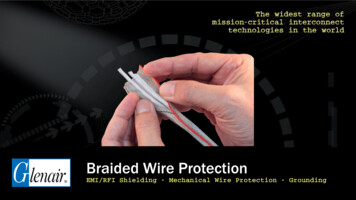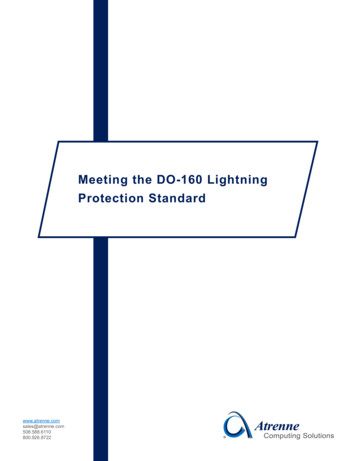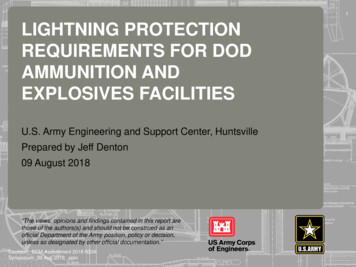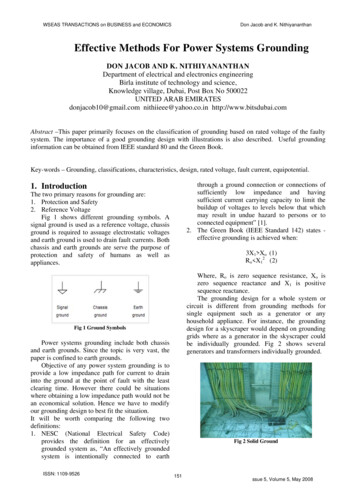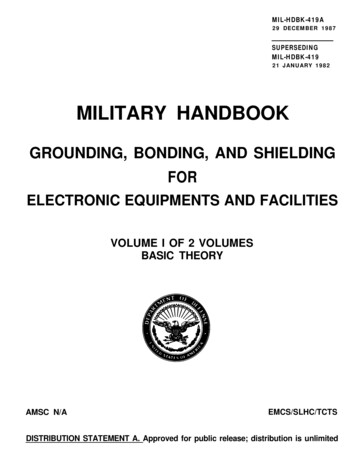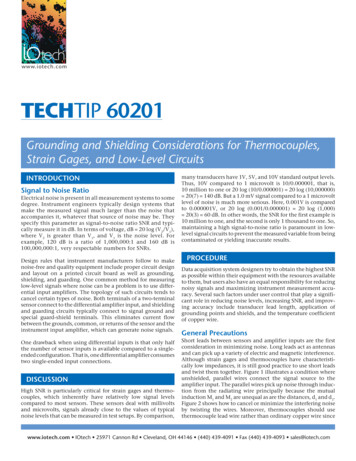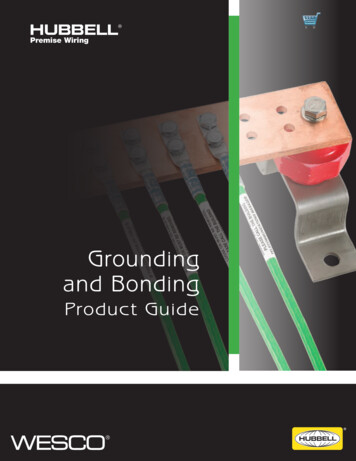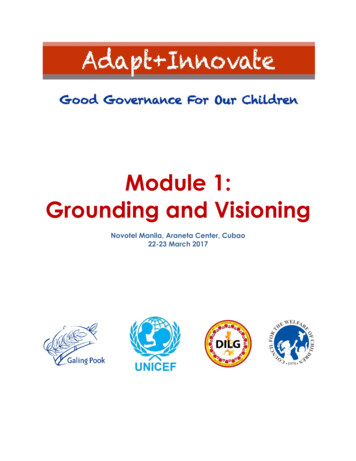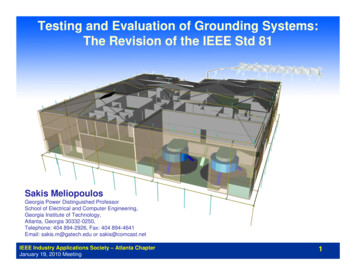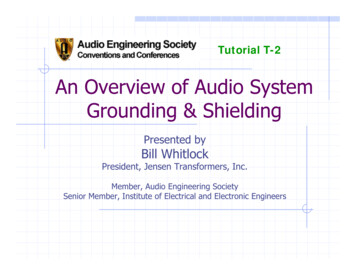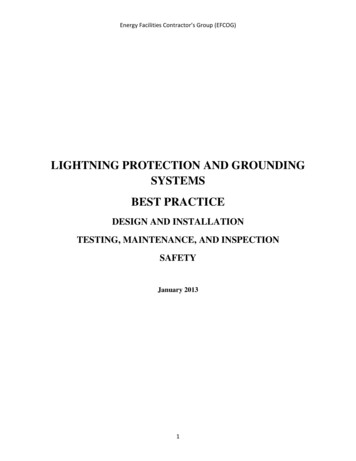
Transcription
Energy Facilities Contractor’s Group (EFCOG)LIGHTNING PROTECTION AND GROUNDINGSYSTEMSBEST PRACTICEDESIGN AND INSTALLATIONTESTING, MAINTENANCE, AND INSPECTIONSAFETYJanuary 20131
Energy Facilities Contractor’s Group (EFCOG)EFCOG Lightning Safety Working Group MembersDavid McAfee, Chairman – Y-12Rick Baca – LANLTerry Crutchfield – Y-12Robert Daley - LANLSamuel Garcia – LANLAjit Gwal – DNFSBRebecca Lopez – SandiaJackie McAlhaney – SRNSKimball Merewether – SandiaMike Robertson – Schneider ElectricBrian Sautter – DOE SRSSal Sferrazza – NRELJames Wright – BNLMax Wright – Pantex2
Energy Facilities Contractor’s Group (EFCOG)Table of ContentsAbbreviations and Acronyms . 5Definitions . 5Chapter 1 Introduction . 61.1Objectives . 61.2Background . 61.3Requirements . 8CHAPTER 2 LIGHTNING HAZARDS AND PROTECTION . 102.1Lightning Hazards. . 102.2Protection. . 10CHAPTER 3 CHARACTERISTICS OF LIGHTNING . 123.1General . 123.2Current in a Lightning Flash . 143.3Voltage. . 143.4Effects of a Lightning Strike on an LPS . 15CHAPTER 4 DESIGN BASIS . 164.1General Criteria . 164.2Risk Assessment/Need for a LPS. 174.3Design Requirements . 18CHAPTER 5 TESTING, MAINTENANCE AND INSPECTION. 215.1Inspection Overview . 215.2Inspection Criteria . 215.3Acceptance Criteria . 22Chapter 6 Personnel Safety . 256.1General . 256.2Planning for Personnel Warning . 256.3General Guidance for Outdoor Workers . 266.4General Guidance for Safe Shelters and Indoors . 273
Energy Facilities Contractor’s Group (EFCOG)6.5Guidance for Organized Outdoor Events . 276.6First Aid for Lightning Victims . 28REFERENCES . 29Appendix B Recommended Work Steps for Inspection of Facility Lightning Protection System . 304
Energy Facilities Contractor’s Group (EFCOG)Abbreviations and Acronyms F – Degree Fahrenheit C – Degrees CelsiusAHJ – Authority Having JurisdictionDOD – Department of DefenseDOE – Department of EnergyEFCOG – Energy Facilities Contractor’s GroupLPI – Lightning Protection InstituteLPS – Lightning Protection SystemNFPA – National Fire Protection AssociationNLDN – National Lightning Detection NetworkNOAA – National Oceanic & Atmospheric AdministrationSPD – Surge Protective DeviceTM&I – Testing, Maintenance & InspectionUL – Underwriter’s LaboratoryDefinitionsDefinitions are as found in NFPA 780, Chapter 35
Energy Facilities Contractor’s Group (EFCOG)Chapter 1Introduction1.1Objectives1.1.1 The primary focus of this EFCOG best practice is to provide clarification forDepartment of Energy (DOE) facilities lightning protection requirements outlined in theNational Fire Protection Association (NFPA) 780, Standard for the Installation ofLightning Protection Systems. This document addresses requirements for providingprotection to facilities and to personnel within or near these facilities from theconsequences of a lightning-induced event. This document does not apply to explosivefacilities as defined in DOE 1212 or structures housing explosives as defined by NFPA780.1.1.2 The fundamental principle in protection of life and property against lightning isprovision of a means by which lightning discharge can enter or leave earth with noresulting damage or loss to the facility or occupants. A low-impedance path to ground isnecessary to ensure this continuous discharge, and to attempt to manage the path ofcurrents, minimizing undesirable current flow through building materials, equipment orpersonnel. The low impedance path to ground is achieved by providing strike terminationdevices on the high point of the structure, multiple interconnecting conductors, and aground electrode system.1.2Background1.2.1. Lightning is an atmospheric discharge of electricity that typically occurs duringthunderstorms, and sometimes during volcanic eruptions or dust storms. Lightning can alsobe caused by violent forest fires that generate sufficient dust or wind to create a staticcharge. A bolt of lightning can travel at a speed of 136,000 miles per hour (220,000kilometer per hour) and can reach temperatures approaching 54,000 degrees Fahrenheit( F) [30,000 degrees Celsius ( C)], hot enough to fuse soil or sand into glass.1.2.2. Over 16 million lightning storms occur every year. How lightning initially forms isstill a matter of debate. Scientists have studied root causes ranging from atmosphericperturbations (wind, humidity, and atmospheric pressure) to the impact of solar wind andaccumulation of charged solar particles. Ice inside a cloud is thought to be a key element inlightning development, and may cause a forcible separation of positive and negativecharges within the cloud, thus assisting in the formation of lightning.1.2.3. In any U.S. geographical location, lightning storms occur as few as five times or asmany as 100 times per year. Figure 1.1 illustrates typical US distribution of lightningflashes from 1997 to 2010 from the National Lightning Detection Network (NLDN ) byVaisala.1.2.3.1 A single lightning flash (event) will typically consist of from one to twenty or moreindividual current strokes with the average being between four and seven.1.2.3.2. Some of the most powerful and dangerous thunderstorms occur over the UnitedStates, particularly in the Midwest and the southern states. These storms can also producelarge hail and powerful tornadoes.6
Energy Facilities Contractor’s Group (EFCOG)1.2.3.3. Thunderstorms are relatively uncommon along much of the West Coast of theUnited States, but they occur with greater frequency in the inland areas, particularly theSacramento Valley and San Joaquin Valley. Furthermore, in spring and summer, they occurnearly daily in certain areas of the Rocky Mountains.1.2.3.4. In the Northeast, storms take on similar characteristics and patterns as theMidwest, only less frequently and severely. Probably the most thunderous region outside ofthe Tropics is Florida. During the summer, violent thunderstorms are an almost dailyoccurrence over central and southern parts of that state.1.2.3.5. Each year, thousands of industrial, commercial, residential, and other propertiesare damaged or destroyed by lightning. It accounts for more than a quarter billion dollars inproperty damage annually in the United States. Lightning is responsible for more deathsand property loss than tornadoes and hurricanes combined, and of these violent forces ofnature, lightning is the only one where protection can be economically provided.Figure 1.1 Lightning Flash Density for US 1997 to 2010NLDN , Vaisala7
Energy Facilities Contractor’s Group (EFCOG)1.3RequirementsDOE Orders and Standards Requirements Flow Chart10 CFR 851§ 851.27DOE 420.1-3DOE 420.1CDOE 420.1-1DOE STD1020-2012DOE STD1066-2012DOE STD1212-2012NFPA 780NFPA 780NFPA 780LPI 175 & 177UL Application GuideUL 96UL 96AUL 14498
Energy Facilities Contractor’s Group (EFCOG)1.3.110 CFR 851;§ 851.27, Reference Sources.1.3.2DOE Order 420.1C, Facility Safety1.3.3 DOE Guide 420.1-1 Nonreactor Nuclear Safety Design Guide For Use With DOE O420.1C, Facility Safety1.3.4 DOE G-420.1-3, Implementation Guide for DOE Fire Protection and EmergencyServices Programs for Use with DOE O 420.1C1.3.5 DOE-STD-1020-2012, DOE Standard, Natural Phenomena Hazards Analysis andDesign Criteria for DOE Facilities1.3.6DOE-STD-1066, DOE Standard, Fire Protection1.3.7 National Fire Protection Association (NFPA) 780, Standard for the Installation ofLightning Protection Systems1.3.8 Underwriter’s Laboratory (UL), Marking and Application Guide for LightningProtection1.3.9UL 96, Lightning Protection Components1.3.10 UL 96A, Installation Requirements for Lightning Protection Systems1.3.11 UL 1449, Surge Protective Devices1.3.12 Lightning Protection Institute (LPI), LPI-175, Standard of Practice for the Design,Installation, and Inspection of Lightning Protection Systems1.3.13 LPI-177, Inspection Guide for Certified Systems9
Energy Facilities Contractor’s Group (EFCOG)CHAPTER 2LIGHTNING HAZARDS AND PROTECTION2.1Lightning Hazards.Lightning hazard to facilities and personnel can take many forms:2.1.1. Electrical current produced by a voltage gradient resulting from a lightning flash toa facility can initiate physical damage, fires, equipment damage or injury to personnel.2.1.2. Surface flashover or arcing of generated electrical current between conductivesurfaces not in equilibrium can initiate damage directly by the heat, sparks, and moltenmetal generated by the arc.2.1.3 Sideflash is an electrical spark caused by differences of potential that occursbetween conductive metal bodies or between conductive metal bodies and a component ofthe Lightning Protection System (LPS) or earth electrode system during a lightning flash.Sideflash presents direct and indirect hazards to facilities, hazardous environments andpersonnel both internal and external to the facility. The direct hazard is the electrical energytransferred from the structure or its LPS to building components or personnel. Indirecthazards are the heat and the electromagnetic fields generated by the electrical energy whichcan cause concrete to spall or combustible materials to ignite. Electromagnetic fields couldinduce electrical currents on or in the building or equipment.2.1.4. Generated arcing can cause damage or fires in electrical fixtures and equipment.2.1.5. Lightning could initiate a fire involving combustible materials inside the facility.2.1.6. Spalling of concrete or other surface materials generated by the heat of the currentflowing through the structural components of the facility can physically damage equipmentin the facility. Such spalling may also present an injury risk to personnel.2.1.7. Lightning can affect support systems such as communication, CATV, fireprotection, HVAC, and security systems.2.1.8 Lightning can reach a structure not only by direct strike, but also indirectly bycoupling to conductors or conductive utility services that penetrate the structure.2.1.9 Lightning discharges will produce electromagnetic pulses that can be coupled ontoconductors servicing the structure. These induced surges can be adequate to causedangerous over-voltages, resulting in fires or damage to critical electrical and electronichardware. Surge protection devices protect facilities against induced surges on power,communication, data and process control lines, and any other electrically conductiveobjects entering or exiting the facilities2.2Protection.2.2.1 When lightning follows higher impedance paths, damage may be caused by heatand mechanical forces generated during the discharge process. Most metals, being goodelectrical conductors, are relatively unaffected by either heat or mechanical forces if theyare of sufficient size to carry the expected magnitude
National Fire Protection Association (NFPA) 780, Standard for the Installation of Lightning Protection Systems. This document addresses requirements for providing protection to facilities and to personnel within or near these facilities from the consequences of a lightning-induced event. This document does not apply to explosiveFile Size: 651KBPage Count: 32People also search forlightning protection design standardslightning protection specification section
